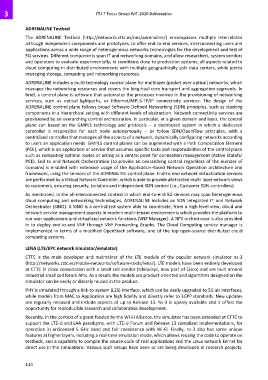Page 120 - ITU-T Focus Group IMT-2020 Deliverables
P. 120
3 ITU-T Focus Group IMT-2020 Deliverables
ADRENALINE Testbed
The ADRENALINE Testbed (http://networks.cttc.es/ons/adrenaline/) encompasses multiple interrelated
although independent components and prototypes, to offer end-to-end services, interconnecting users and
applications across a wide range of heterogeneous networks technologies for the development and test of
5G services. Different components span IT and networking domains, and allow researchers, system vendors
and operators to evaluate experimentally, in conditions close to production systems, all aspects related to
cloud computing in distributed environments with multiple geographically split data centers, while jointly
managing storage, computing and networking resources.
ADRENALINE includes a multi-technology control plane for multilayer (packet over optical) networks, which
manages the networking resources and covers the long-haul core transport and aggregation segments. In
brief, a control plane is software that automates the processes involved in the provisioning of networking
services, such as optical lightpaths, or Ethernet/MPLS-TP/IP connectivity services. The design of the
ADRENALINE control plane follows broad Software Defined Networking (SDN) principles, such as stacking
components in a hierarchical setting with different levels of abstraction. Network connectivity services are
provisioned by an overarching control orchestration. In particular, at a given domain and layer, the control
plane can based on the GMPLS technology and protocols -- a distributed system in which a dedicated
controller is responsible for each node autonomously -- or follow SDN/OpenFlow principles, with a
centralized controller that manages all the aspects of a network, dynamically configuring networks according
to users an application needs. GMPLS control planes can be augmented with a Path Computation Element
(PCE), which is an application or service that assumes specific tasks and responsibilities of the control plane
such as computing optimal routes or acting as a central point for connection management (Active Stateful
PCE). End to end Network Orchestration (to provide an overarching control regardless of the number of
domains) is enabled with extensive usage of the Application-Based Network Operation architecture and
framework, using the services of the ADRENALINE control plane. End-to-end network virtualization services
are performed by a Virtual Network Controller, which is able to provide abstracted multi-layer network views
to customers, ensuring security, isolation and independent SDN control (i.e., Customer SDN controllers).
As mentioned, in the all-interconnected context in which end-to-end 5G services may span heterogeneous
cloud-computing and networking technologies, ADRENALINE includes an SDN Integrated IT and Network
Orchestrator (SINO). A SINO is a centralized system able to coordinate, from a high-level view, cloud and
network service management aspects in modern multi-tenant environments which provides the platform to
run user applications and virtualized network functions (VNF Manager). A NFV orchestrator is also provided
in to deploy end-to-end VNF through VNF Forwarding Graphs. The Cloud Computing service manager is
implemented in terms of a modified OpenStack software, one of the top open-source distributed cloud
computing systems.
LENA (LTE/EPC network simulator/emulator)
CTTC is the main developer and maintainer of the LTE module of the popular network simulator ns-3
(http://networks.cttc.es/mobile-networks/software-tools/lena/). LTE models have been entirely developed
at CTTC in close consultation with a small cell vendor (Ubiquisys, now part of Cisco) and are built around
industrial small cell forum APIs. As a result, the models are product-oriented and algorithms designed on the
simulator can be easily or directly reused in the product.
PHY is simulated through a link-to-system (L2S) interface, which can be easily upgraded to 5G air interfaces,
while models from MAC to Application are high fidelity and directly refer to 3GPP standards. New updates
are regularly released and include aspects of up to Release 13. Ns-3 is openly available and it offers the
opportunity for reproducible research and collaborative development.
Recently, in the context of a grant funded by the Wi-Fi Alliance, the simulator has been extended at CTTC to
support the LTE-U and LAA paradigms, with LTE-U Forum and Release 13 compliant implementations, for
operation in unlicensed 5 GHz band and fair coexistence with Wi-Fi. Finally, ns-3 also has some unique
features at higher layers, including a real-time emulation mode, which allows reusing the code to operate on
testbeds, and a capability to compile the source code of real applications and the Linux network kernel for
direct use in the simulations. Various such setups have been or are being developed in research projects,
114

